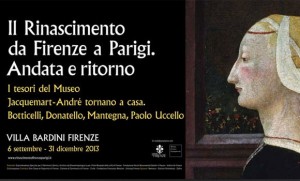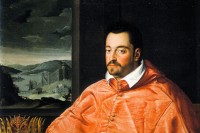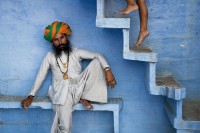By Giulia Bagni (University of Florence)
Open until the 31st of December 2013 to visitors, the exhibition at the Villa Bardini “The Renaissance from Florence to Paris and Back. Treasures of the Jacquemart André Museum return home”. Clearly from the title, the exposition intends to illustrate a small part of the masterpieces, which among the end of the eighteenth century and the start of the nineteenth century through the sales of the famous antiquities dealer in Florence Stefano Bardini, were purchased by the couple Nélie and Édouard Jacquemart-André in order to enrich their private collection; the decision to hold the exhibition at the Villa Bardini is not by chance.
The exposition is situated on the third floor of the villa and is articulated into six small sections. The pathway of the visit is not clear, but the presence of the diligent staff and a brochure that you can take at the entrance, allows you to orient yourself.
There are two dominant colors of the arrangement: the green of the fabric which covers the walls, which allows the gold of the frames to stand out and the blue of the panels with the text in both Italian and English introduces the difference sections. The explanations on the panels are detailed and effective, without being long-winded: it starts with a description of the married French collectors, and their relationship with the antiquities dealer Bardini; it continues with an outline of the profile of Nélie Jacquemart, who was the matron of the collection. Finally, the last sections illustrates the birth of the Museum Jacquemart André of Paris and Bardini of Florence, and it is also accompanied with the help of photographs of the period which describes the disposition of the Paris collection. It is possible to recognize some works that are now exposed in the Villa, within the photographs.
During the exhibition it constantly shows the visitor the close relationship between the personality of the antiques dealer and the two collectors. This relationship is witnessed by many purchases, and also by the influence that Bardini exercised with his gallery on the arrangement of the rooms in the Parisian household: these rooms advocate the ambiance of the Renaissance and the objects are disposed following principle aesthetic values.
To give the visitor the idea of the disposition of the Galleria Bardini, the curators recreated a room of the gallery using a photographic reproduction that covers the entire wall and put close to the wall some works that come from the Museo Bardini (located in Palazzo Mozzi). Except the curators are not trying to recreate the arrangement of the Parisian museum, which is similar to the Galleria Bardini. It has been expressed through the presentation of the photographs of the period, in order for the public viewers to appreciate the entirety of the beauty of the exposed work. However, they are not illuminated very well.
Another positive aspect of the exhibition is that the curators have not expressed the negativity of the figure Bardini, who is often described as a vile art dealer, but diverts the attention to the common interests and the love of art between the three personalities.
The ultimate point regarding the choice of the exposed objects: the curators have selected for a large part of paintings, and they left out the rich section of sculpture from the Jacquemart André museum.
With one ticket, you can visit all of the parts of the museum, including all of the temporary exhibitions, the Annigoni e Capucci museums, and the splendid Villa gardens that offers a breath-taking panorama of the city of Florence.
For more information visit the website http://www.renaissanceflorenceparis.com/
Il Rinascimento da Firenze a Parigi. Andata e ritorno. I tesori del museo Jacquemart André tornano a casa.
Giulia Bagni (Università di Firenze)
Fino al 31 Dicembre si può visitare presso Villa Bardini la mostra “Il Rinascimento da Firenze a Parigi. Andata e ritorno. I tesori del museo Jacquemart André tornano a casa”.
Come si intuisce dal titolo, l’esposizione intende illustrare una piccolissima parte di quei capolavori che, tra la fine dell’Ottocento e i primi del Novecento, attraverso le vendite del noto antiquario Stefano Bardini a Firenze, furono acquistate dai coniugi Nélie e Édouard Jacquemart-André al fine di arricchire la loro collezione privata; la scelta di ospitare la mostra presso Villa Bardini non è quindi casuale.
L’esposizione si trova al terzo piano della villa e si articola in sei piccole sezioni. Il percorso di visita non è molto chiaro ma, grazie alla presenza di solerti custodi e a una brochure che si può prendere all’ingresso, si riesce ad orientarsi.
I colori dominanti dell’allestimento sono due: il verde della stoffa che ricopre le pareti delle sale, su cui ben risaltano le cornici dorate delle opere, e il blu dei pannelli, con testi in italiano e in inglese, che introducono le diverse sezioni. Le spiegazioni fornite al visitatore sono molto dettagliate, senza essere prolisse, ed efficaci: si comincia con una presentazione della coppia di collezionisti francesi, a cui è affiancata quella dell’antiquario Bardini; si prosegue col tratteggiare il profilo di Nélie Jacquemart, colei a cui si deve maggiormente la nascita della collezione; infine, l’ultima sezione illustra la nascita dei Musei Jacquemart André di Parigi e Bardini di Firenze, anche con l’aiuto di fotografie d’epoca che chiariscono la disposizione della collezione parigina e in cui è possibile rintracciare alcune delle opere in mostra.
Questo continuo raffronto tra l’attività e la personalità dell’antiquario e dei due collezionisti trasmette al visitatore lo stretto rapporto che si venne a creare tra loro; rapporto testimoniato, oltre che dai numerosi acquisti, anche dall’influenza che Bardini esercitò, con la sua galleria, nell’allestimento della sale dell’abitazione parigina dei collezionisti: stanze evocative di ambienti rinascimentali in cui gli oggetti erano disposti, come oggi, seguendo principi estetici.
Per fornire al visitatore un’idea di quello che era l’allestimento della Galleria Bardini si è provveduto a ricrearne una stanza grazie all’uso di una riproduzione fotografica che è stata “stampata” direttamente sulle pareti, a cui sono state accostate alcune opere provenienti dal museo Bardini (situato in Palazzo Mozzi). A parte questo tentativo, i curatori non hanno voluto in alcun modo riproporre l’allestimento del museo parigino, molto simile a quello della Galleria Bardini e già evocato attraverso la presentazione di fotografie d’epoca, così che il pubblico possa godersi appieno tutte le opere esposte che, va detto, non sempre sono illuminate in maniera ottimale.
Un altro pregio della mostra risiede nel fatto di non aver insistito troppo sugli aspetti negativi della figura di Bardini, descritto spesso come un vile commerciante, ma di aver puntato l’attenzione sugli interessi comuni e l’amore per l’arte che univano queste tre personalità.
L’ultimo appunto riguarda la scelta delle opere da esporre: i curatori hanno selezionato per la maggior parte opere pittoriche, trascurando tutta la sezione di scultura di cui il museo Jacquemart André è ricco.
Da non tralasciare il fatto che nel prezzo del biglietto sono comprese anche la visita alle eventuali altre mostre temporanee, ai musei Annigoni e Capucci e infine allo splendido Giardino della Villa che offre un panorama mozzafiato sulla città di Firenze.
Per ulteriori informazioni consultare il sito http://www.rinascimentofirenzeparigi.it/



